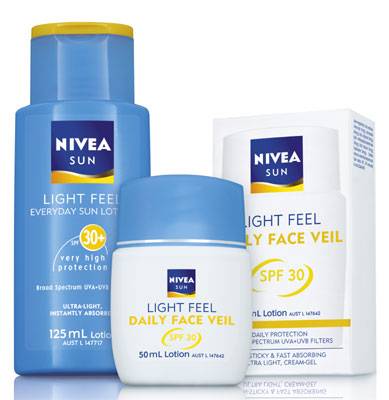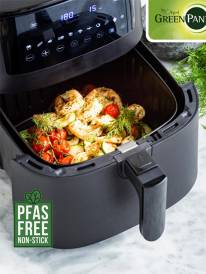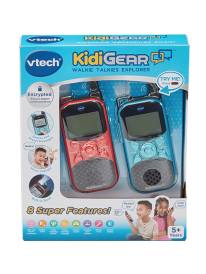Nivea Sun Sunscreen 101

Introducing NIVEA SUN Light Feel - maximum protection you can barely feel!
It's no secret that the best anti-ageing cream around is sunscreen. While 90% of Australians* always cover up at the beach, we often forgo sticky sunscreens elsewhere despite damaging, incidental UV ray exposure. That's why NIVEA SUN has developed a sun protection range that you can barely feel: new NIVEA SUN Light Feel.
New NIVEA SUN Light Feel Everyday Sun Lotion SPF30+ offers maximum sun protection, specially formulated to feel like an everyday body moisturiser. Utilising NIVEA's skin care expertise, lightweight moisturising ingredients have been combined with broad-spectrum SPF30+ UVA and UVB filters to create a sunscreen that is lightweight without compromising maximum protection.
New NIVEA SUN Light Feel Everyday Sun Lotion SPF30+ absorbs immediately without any greasiness, leaving skin feeling silky and supple. The convenient, hand-bag sized bottle is perfect for daily protection on all occasions. From a morning at the markets, lunch at a terrace bar or a day at the races, even under your silk cocktail dress, Light Feel Everyday Sun Lotion is barely felt!
For everyday face protection from the sun's harmful rays, NIVEA SUN has developed new NIVEA SUN Light Feel Face Veil SPF30. This moisturising, non-greasy formula offers very high protection against sun damage and premature ageing by creating a protective veil against UVA and UVB rays. It contains no solid particles so it is instantly absorbed into the skin, leaving you protected in complete comfort with a 'barely there' feeling.
Because of the superior, lightweight formula, NIVEA SUN Light Feel Face Veil SPF30 is ideal for wearing under your make-up; protecting your skin from premature ageing every day!
Say goodbye to thick lotions and Casper-complexions, and say hello to sunscreen so light it feels barely there. Whether you're enjoying a picnic lunch, relaxing at a backyard BBQ or having a few drinks with friends, the new Light Feel range is perfect for life under the Australian sun. Always read the label. Use only as directed.
Ken Lee, NIVEA R&D Manager, answers everything you wanted to know about sunscreen!
How does sunscreen actually work?
Sunscreen protects us from UV rays. When it's on your skin, it can either absorb the energy from the UV rays so your skin does not, reflect the UV rays away, or do a combination of both.
What does the SPF factor actually mean?
The SPF factor is a short way of informing consumers of the multiple of time that a person may be prevented from sunburn. It compares how many multiples of minutes you are prevented from sunburn for your given type of skin. For example, if you are fair and usually see the very first signs of sunburn (reddening) in 10 minutes, then a factor 30 sunscreen means that you are protected for 30 times as long to see the same first signs of sunburn, ie. 300 minutes. It is important to remember however, the factor represents an idealised calculation and should only always be used as a guide. In reality, there are many variables which alter this equation such as your particular skin type, time of day, time of year, how well your sunscreen is applied, quality of sunscreen, amount used, etc.
What's the difference between UVA and UVB rays?
UVA rays, with their relatively longer wavelength, penetrate deeper into the skin, into the dermal layer. Its damage tends to be seen later on, such as prematurely aged skin and wrinkles.
UVB rays, have a shorter wavelength and higher energy. They don't penetrate as deeply and its damage is seen immediately on the epidermal layer of the skin, such as the redness of sunburn.
What's the difference between physical and chemical sunscreen?
So-called 'physical' sunscreens are those where the sunscreen agent almost exclusively reflects the damaging UV rays. These tend to be made from minerals such as titanium dioxide or zinc oxide. The so-called 'chemical' sunscreens are those where the sunscreen agents absorb the energy of the UV rays. If you like, think of the aluminium foil under your kitchen grill as the physical sunscreen and a piece of bread sitting upon the foil under as your chemical filter. The aluminium foil reflects the heat, whereas the piece of bread absorbs the heat (and hence turns brown).
If I put on sunscreen at the beach and then go straight in the water, do I need to top-up when I get out?
You should always reapply sunscreens after going into the water.
If you plan to be in the water, then look out for "water resistant" sunscreens and the extent of water resistance protection provided. These formulations have been designed to be 'film-forming' which means it is less likely to wash off in the water.
And what if I never go into the water - does that mean I'm protected all day at the beach?
No. It is always a good idea to reapply frequently. If you remember, there are sunscreens that reflect UV, and those which absorb UV - and in reality, most products on the market use a combination of both to achieve the best possible protection.
So where there are sunscreens that absorb UV, these are intended to deteriorate as they absorb the UV, so reapplication is necessary. Think back to that piece of bread under your kitchen grill, as it turns brown and black by absorbing the radiant heat, it will need to be replaced.
Is there such a thing as laying on the beach safely?
Unfortunately no! Furthermore, there are particular times - such as between 10am and 2pm in the middle of summer - when laying on the beach without sun protection will definitely cause you harm. The 'slip, slop, slap' campaign exists for a reason!
I use an SPF 30 moisturiser and an SPF 15 foundation - does that mean I have a protection of SPF 45?
No. This is a common myth. The factors are non-cumulative and there are many variables. Remember that the SPF is a guide and is affected by many things. Continue to use high SPF skin products for best protection from damaging UV rays.
Am I still protected in the afternoon if I put on sunscreen in the morning?
Again, there are many variables to consider - how much was applied in the first place, how much was rubbed off, how much exposure have you had in the morning etc. Generally, if you have the opportunity, you should try and reapply.
Should I put my daily facial sunscreen under or over my moisturiser?
The UV rays from the sun are not too fussy - having travelled all the way from the sun to your skin, it does not matter too much whether it is absorbed or reflected before or after your moisturiser. Use a pattern you feel most comfortable with. NIVEA SUN Light Feel Daily Face Veil SPF30 is so light that it may be better under your moisturiser should you need it.
So, if I used to get burnt as a kid - does that mean I'm going to get more wrinkles later in life?
Regretfully, the UV damage you may have had as a kid may stay with you later in life. However, all the steps you take now to minimise further damage, no matter how small, will be beneficial as you get older. There are also now several products on the market - such as NIVEA's DNAge range - which can help minimise past damage and protect you from future damage.
Do you still get the benefits of Vitamin D if you're wearing sunscreen?
Yes. Most Australians will receive enough of the sun in their everyday activities to generate sufficient levels of Vitamin D without deliberately exposing themselves to the sun. Even in the middle of winter in Australia, sun exposure on your face, arms and hands for 2 to 3 hours a week is more than sufficient for your body to make its own Vitamin D. Also, Vitamin D is stored in fat and muscle and your body can rely on these tissue stores for between 30 and 60 days.
Should I still wear sunscreen on a cloudy day?
Yes. Cloud cover is not a good indication of protection against UV. Whilst some rays may be reflected by cloud, enough do penetrate cloud cover and these are still damaging on your skin.
Can I get sunburnt in my car?
Yes. Whilst you may protect your eyes with sunglasses, your skin is still exposed to UV rays, which like light, are reflected off many other surfaces. The indirect exposure (say from the road) reflects damaging UV rays which can sufficiently cause damage and sunburn.
Why should we bother with sunscreens?
Australians suffer from one of the highest rates of skin cancers in the world. Sun exposure is the cause of nearly all non-melanoma skin cancers and about 95% of melanoma in Australia. It is therefore important to protect yourself from the sun, to reduce your chance of getting skin cancer.
Melanoma cancer is amongst the most commonly diagnosed cancers, especially in the younger population. For non-melanoma skin cancer, based on the most recent survey in 2002, there are projected to be around 433,000 new cases in 2008, of which 295,000 will be basal cell carcinoma and 138,000 squamous cell carcinoma.* The statistics speak for themselves!
* Source: Australian Institute of Health and Welfare 2008. Australia's Health 2008. Cat No. AUS 99, Canberra: AIHW.
It's no secret that the best anti-ageing cream around is sunscreen. While 90% of Australians* always cover up at the beach, we often forgo sticky sunscreens elsewhere despite damaging, incidental UV ray exposure. That's why NIVEA SUN has developed a sun protection range that you can barely feel: new NIVEA SUN Light Feel.
New NIVEA SUN Light Feel Everyday Sun Lotion SPF30+ offers maximum sun protection, specially formulated to feel like an everyday body moisturiser. Utilising NIVEA's skin care expertise, lightweight moisturising ingredients have been combined with broad-spectrum SPF30+ UVA and UVB filters to create a sunscreen that is lightweight without compromising maximum protection.
New NIVEA SUN Light Feel Everyday Sun Lotion SPF30+ absorbs immediately without any greasiness, leaving skin feeling silky and supple. The convenient, hand-bag sized bottle is perfect for daily protection on all occasions. From a morning at the markets, lunch at a terrace bar or a day at the races, even under your silk cocktail dress, Light Feel Everyday Sun Lotion is barely felt!
For everyday face protection from the sun's harmful rays, NIVEA SUN has developed new NIVEA SUN Light Feel Face Veil SPF30. This moisturising, non-greasy formula offers very high protection against sun damage and premature ageing by creating a protective veil against UVA and UVB rays. It contains no solid particles so it is instantly absorbed into the skin, leaving you protected in complete comfort with a 'barely there' feeling.
Because of the superior, lightweight formula, NIVEA SUN Light Feel Face Veil SPF30 is ideal for wearing under your make-up; protecting your skin from premature ageing every day!
Say goodbye to thick lotions and Casper-complexions, and say hello to sunscreen so light it feels barely there. Whether you're enjoying a picnic lunch, relaxing at a backyard BBQ or having a few drinks with friends, the new Light Feel range is perfect for life under the Australian sun. Always read the label. Use only as directed.
Ken Lee, NIVEA R&D Manager, answers everything you wanted to know about sunscreen!
How does sunscreen actually work?
Sunscreen protects us from UV rays. When it's on your skin, it can either absorb the energy from the UV rays so your skin does not, reflect the UV rays away, or do a combination of both.
What does the SPF factor actually mean?
The SPF factor is a short way of informing consumers of the multiple of time that a person may be prevented from sunburn. It compares how many multiples of minutes you are prevented from sunburn for your given type of skin. For example, if you are fair and usually see the very first signs of sunburn (reddening) in 10 minutes, then a factor 30 sunscreen means that you are protected for 30 times as long to see the same first signs of sunburn, ie. 300 minutes. It is important to remember however, the factor represents an idealised calculation and should only always be used as a guide. In reality, there are many variables which alter this equation such as your particular skin type, time of day, time of year, how well your sunscreen is applied, quality of sunscreen, amount used, etc.
What's the difference between UVA and UVB rays?
UVA rays, with their relatively longer wavelength, penetrate deeper into the skin, into the dermal layer. Its damage tends to be seen later on, such as prematurely aged skin and wrinkles.
UVB rays, have a shorter wavelength and higher energy. They don't penetrate as deeply and its damage is seen immediately on the epidermal layer of the skin, such as the redness of sunburn.
What's the difference between physical and chemical sunscreen?
So-called 'physical' sunscreens are those where the sunscreen agent almost exclusively reflects the damaging UV rays. These tend to be made from minerals such as titanium dioxide or zinc oxide. The so-called 'chemical' sunscreens are those where the sunscreen agents absorb the energy of the UV rays. If you like, think of the aluminium foil under your kitchen grill as the physical sunscreen and a piece of bread sitting upon the foil under as your chemical filter. The aluminium foil reflects the heat, whereas the piece of bread absorbs the heat (and hence turns brown).
If I put on sunscreen at the beach and then go straight in the water, do I need to top-up when I get out?
You should always reapply sunscreens after going into the water.
If you plan to be in the water, then look out for "water resistant" sunscreens and the extent of water resistance protection provided. These formulations have been designed to be 'film-forming' which means it is less likely to wash off in the water.
And what if I never go into the water - does that mean I'm protected all day at the beach?
No. It is always a good idea to reapply frequently. If you remember, there are sunscreens that reflect UV, and those which absorb UV - and in reality, most products on the market use a combination of both to achieve the best possible protection.
So where there are sunscreens that absorb UV, these are intended to deteriorate as they absorb the UV, so reapplication is necessary. Think back to that piece of bread under your kitchen grill, as it turns brown and black by absorbing the radiant heat, it will need to be replaced.
Is there such a thing as laying on the beach safely?
Unfortunately no! Furthermore, there are particular times - such as between 10am and 2pm in the middle of summer - when laying on the beach without sun protection will definitely cause you harm. The 'slip, slop, slap' campaign exists for a reason!
I use an SPF 30 moisturiser and an SPF 15 foundation - does that mean I have a protection of SPF 45?
No. This is a common myth. The factors are non-cumulative and there are many variables. Remember that the SPF is a guide and is affected by many things. Continue to use high SPF skin products for best protection from damaging UV rays.
Am I still protected in the afternoon if I put on sunscreen in the morning?
Again, there are many variables to consider - how much was applied in the first place, how much was rubbed off, how much exposure have you had in the morning etc. Generally, if you have the opportunity, you should try and reapply.
Should I put my daily facial sunscreen under or over my moisturiser?
The UV rays from the sun are not too fussy - having travelled all the way from the sun to your skin, it does not matter too much whether it is absorbed or reflected before or after your moisturiser. Use a pattern you feel most comfortable with. NIVEA SUN Light Feel Daily Face Veil SPF30 is so light that it may be better under your moisturiser should you need it.
So, if I used to get burnt as a kid - does that mean I'm going to get more wrinkles later in life?
Regretfully, the UV damage you may have had as a kid may stay with you later in life. However, all the steps you take now to minimise further damage, no matter how small, will be beneficial as you get older. There are also now several products on the market - such as NIVEA's DNAge range - which can help minimise past damage and protect you from future damage.
Do you still get the benefits of Vitamin D if you're wearing sunscreen?
Yes. Most Australians will receive enough of the sun in their everyday activities to generate sufficient levels of Vitamin D without deliberately exposing themselves to the sun. Even in the middle of winter in Australia, sun exposure on your face, arms and hands for 2 to 3 hours a week is more than sufficient for your body to make its own Vitamin D. Also, Vitamin D is stored in fat and muscle and your body can rely on these tissue stores for between 30 and 60 days.
Should I still wear sunscreen on a cloudy day?
Yes. Cloud cover is not a good indication of protection against UV. Whilst some rays may be reflected by cloud, enough do penetrate cloud cover and these are still damaging on your skin.
Can I get sunburnt in my car?
Yes. Whilst you may protect your eyes with sunglasses, your skin is still exposed to UV rays, which like light, are reflected off many other surfaces. The indirect exposure (say from the road) reflects damaging UV rays which can sufficiently cause damage and sunburn.
Why should we bother with sunscreens?
Australians suffer from one of the highest rates of skin cancers in the world. Sun exposure is the cause of nearly all non-melanoma skin cancers and about 95% of melanoma in Australia. It is therefore important to protect yourself from the sun, to reduce your chance of getting skin cancer.
Melanoma cancer is amongst the most commonly diagnosed cancers, especially in the younger population. For non-melanoma skin cancer, based on the most recent survey in 2002, there are projected to be around 433,000 new cases in 2008, of which 295,000 will be basal cell carcinoma and 138,000 squamous cell carcinoma.* The statistics speak for themselves!
* Source: Australian Institute of Health and Welfare 2008. Australia's Health 2008. Cat No. AUS 99, Canberra: AIHW.
MORE





